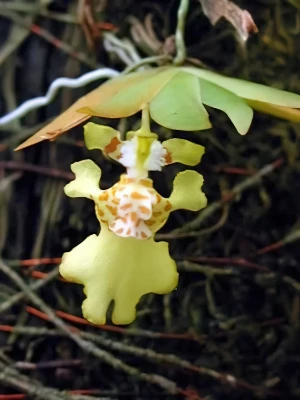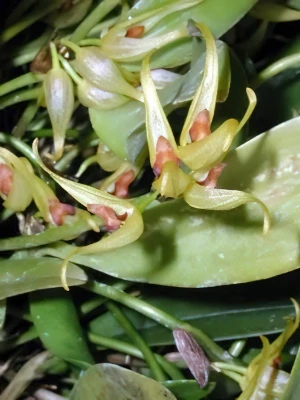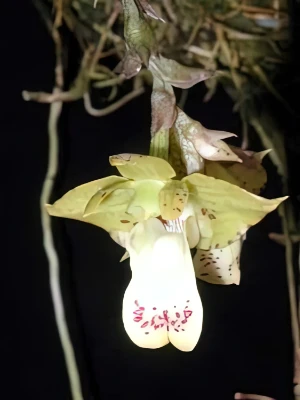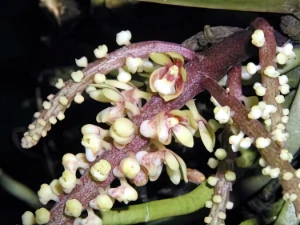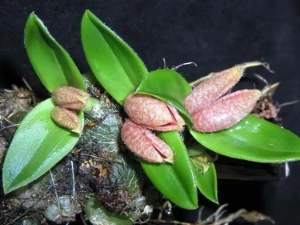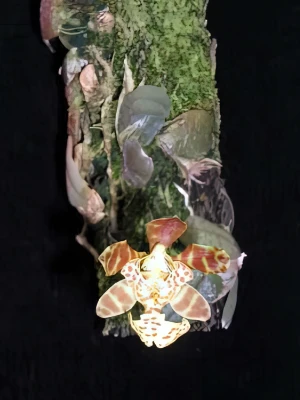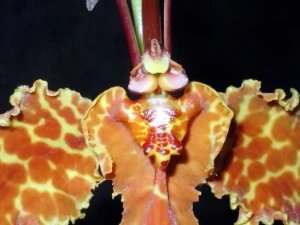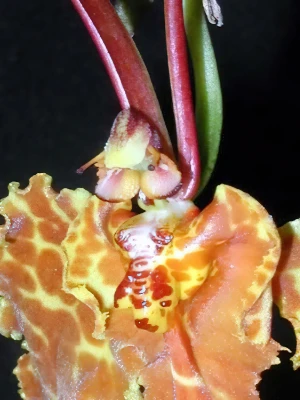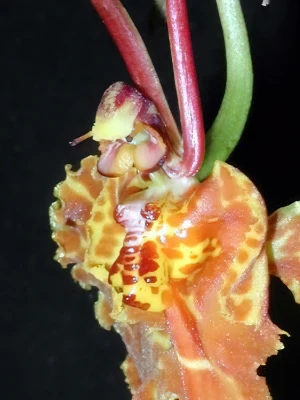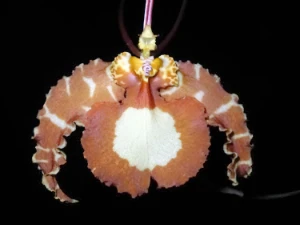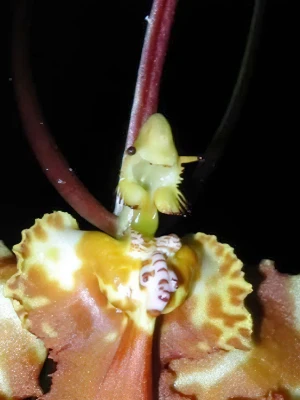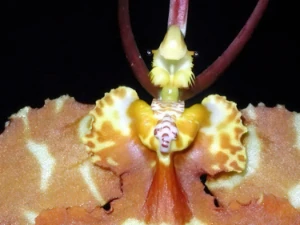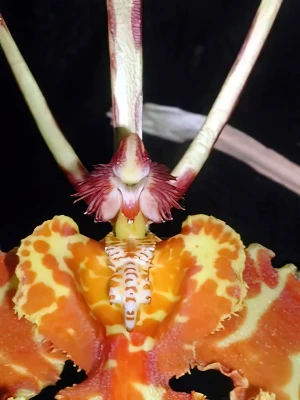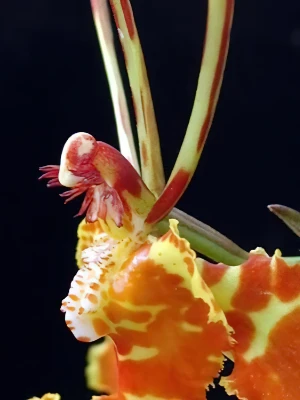Gallery of orchids ❯ Pleurothalis - Psygmorchis
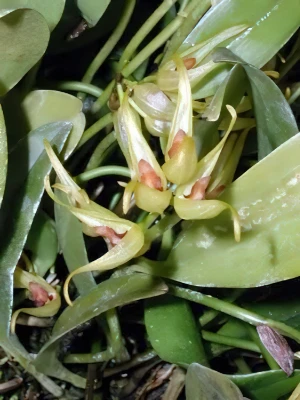
Pleurothalis sp. equador
"Pleurothallis sp. equador" refers to a specific species within the Pleurothallis genus, a large group of orchids found predominantly in South America, including Ecuador. This designation suggests a species endemic to Ecuador, although "sp. equador" appears to be a typographical error, and the correct spelling for the country in botanical references is "Ecuador". Pleurothallis species are notable for their diverse and often small, intricate flowers adapted to humid environments. They play a significant ecological role in their native habitats, serving as important sources of nectar for various pollinators. The exact characteristics of Pleurothallis sp. "Ecuador" would depend on precise species identification, as the genus showcases a wide variety of forms and adaptations.
Pleurothalis teres
Pleurothallis teres is a species belonging to the genus Pleurothallis in the Orchidaceae family, which is distinguished by its unique and diverse group of orchids. This particular species is notable for its slender, upright growth habit and terete (cylindrical) leaves, which contribute to its distinctive appearance. Found in various parts of Central and South America, Pleurothallis teres thrives in montane forests, demonstrating its adaptability to humid and shaded environments. Its flowers, though small, are fascinating to orchid enthusiasts for their intricate shapes and the way they contribute to the biodiversity of their ecosystems.
Polystachia flavescens
Polystachia flavescens is a species of orchid found in parts of Africa. It is notable for its vibrant yellow flowers, which contribute to its descriptor "flavescens," meaning becoming yellow. This orchid is epiphytic, often growing on other plants for support, but not as a parasite. Its significance lies in its contribution to the biodiversity of African orchid flora and its potential use in horticulture. The unique color and the way it adapts to its environment make Polystachia flavescens an interesting subject for both botanical studies and enthusiasts.
Polystachia maculata
Polystachia maculata is a species of orchid known for its distinctiveness and beauty within the Polystachia genus. It is characterized by its uniquely patterned flowers, which exhibit a striking array of spots or marks, hence the name 'maculata' meaning spotted. This orchid stands out due to its adaptability to various environments and its ability to thrive in a range of climatic conditions, making it a favored species among orchid enthusiasts. Botanically, it showcases the intricate relationships within ecosystems, contributing to biodiversity. Its unique morphological characteristics, such as the spotted flowers and growth habit, make it a subject of interest in botanical studies and horticulture.
Pomatocalpa setuense
Pomatocalpa setuense is a species of orchid endemic to Sri Lanka, known for its ecological significance and unique botanical characteristics. This species thrives in specific habitats, showcasing the biodiversity of Sri Lanka's flora. The orchid is notable for its intricate flowers and the role it plays in local ecosystems, particularly in pollination interactions. Its adaptation strategies, such as specialized root systems for nutrient absorption, make it an interesting subject for studies on plant ecology and conservation. Given its limited distribution, Pomatocalpa setuense highlights the importance of habitat preservation to protect such endemic species and maintain biodiversity.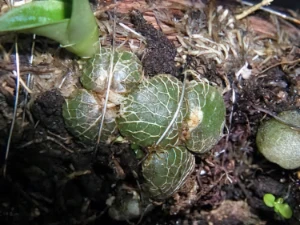
Porpax lanii
'Porpax lanii' refers to a species of orchid unique for its distinctive growth patterns and botanical characteristics. Recognized for its compact size and the peculiar texture of its leaves, this orchid species is appreciated among enthusiasts and scholars for its ornamental qualities and its adaptation to specific ecological niches. It typically thrives in certain forested areas, where its small, yet visually striking, flowers can be observed. The significance of 'Porpax lanii' extends to its contribution to biodiversity and the interest it sparks in the study of orchid evolution and conservation.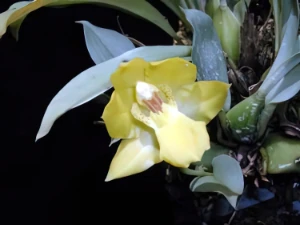
Promenea xanthina
Promenea xanthina is a unique and striking orchid species native to South American rainforests, predominantly found in Brazil. It is renowned for its vibrant, yellow flowers that contribute significantly to its ornamental value, making it a sought-after species among orchid enthusiasts and collectors. As a member of the Orchidaceae family, it thrives in warm, humid conditions, typical of tropical ecosystems. Its exceptional beauty and rarity underline its importance in biodiversity conservation efforts, as well as in the horticultural industry. Botanical characteristics include a compact growth habit, with distinctively colored blooms that have a waxy texture, often attracting pollinators in its natural habitat.
Psychopsiella limminghei
Psychopsiella limminghei is a species of orchid native to tropical areas of the Americas, particularly celebrated for its striking floral displays. It is epiphytic, meaning it grows upon other plants without drawing nutrients from them, instead absorbing moisture and nutrients from the air. Characterized by its vibrant flowers and compact growth habit, Psychopsiella limminghei plays a significant role in horticulture, contributing to the diversity and beauty of cultivated orchid collections. Its cultivation among enthusiasts underscores the importance of preserving exotic plant species and their natural habitats.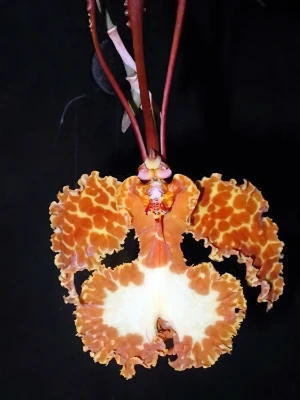
Psychopsis krameriana
Psychopsis krameriana, also known as Kramer's Psychopsis, is a distinctive species of orchid native to parts of Central and South America. It features a unique, butterfly-shaped flower, with long, antenna-like petals and sepals, which contribute to its common name, the butterfly orchid. This epiphytic plant is noted for its remarkable floral mimicry, designed to attract pollinators. Its flowers, which can bloom successively over several months on the same stalk, display vibrant colors, typically a combination of yellow, brown, and red. Psychopsis krameriana is valued for its ornamental appeal, making it a popular choice among orchid enthusiasts and collectors.
Psychopsis papilio
Psychopsis papilio, commonly known as the butterfly orchid, is a captivating species of orchid native to Central and South America. Its name, 'papilio,' is derived from Latin, meaning 'butterfly,' which accurately describes the appearance of its vibrant and distinct flowers. The orchid is renowned for its unique, long antennae-like petals and sepals, resembling a butterfly in flight. This epiphytic plant thrives in humid, tropical environments, often found in the canopies of forests. Its striking beauty and intriguing form make it a favorite among orchid enthusiasts, contributing to its significance in both horticulture and conservation efforts.
Psychopsis versteegiana
Psychopsis versteegiana is a unique species of orchid native to tropical regions of South America, particularly in Ecuador and Peru. Known for its remarkable butterfly-like appearance, the petals of this orchid mimic the wings of a butterfly, a fascinating example of mimicry in nature. This medium-sized epiphyte is distinguished by its long, slender inflorescences that bear singular, strikingly patterned flowers. The plant's significance lies not only in its ornamental value but also in its contribution to the biodiversity of tropical ecosystems, underscoring the importance of conserving its natural habitats.